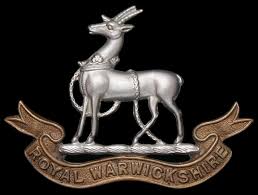Personal Details
Born: 6 April 1899 in Whitchurch, Shropshire.
Family: He was the fifth of eight children born to George Jukes, a painter, and his wife Florence Mary. He married Margaret Ellen Eden in 1932 in Richmond, Yorkshire and together they had five children – Norman D, Rene M, Brian K, Nora and Pauline.
Residence: In 1901 he lived at 12 Pepper Street, Whitchurch; by 1911 the family had moved to 32a Claypit Street, Whitchurch. In 1919 the Absent Voters’ Register showed his address as 50 Egerton Road and by 1939 he had moved to 31 Egerton Road where he lived at the time of his death.
Employment: In 1939 he was an iron roofer charge hand.
Died: In 1971 in Whitchurch and buried in Whitchurch cemetery on 20 July the same year.
Military Details
Regiment: Royal Warwickshire Regiment (previously Machine Gun Corps and prior to that Royal Warwickshire regiment).
Rank: Acting Corporal
Service Number: 43383 (previously 73639 and 9285)
Date of Enlistment: Not known
Date of Discharge: Not known
Reason for Discharge: Not known
Other Information: Brother of George Edward and William Harry Jukes who both served in WW1.
Charles was awarded the Campaign Medals (British War Medal and Victory Medal)

The British War Medal (also known as 'Squeak') was a silver or bronze medal awarded to officers and men of the British and Imperial Forces who either entered a theatre of war or entered service overseas between 5th August 1914 and 11th November 1918 inclusive. This was later extended to services in Russia, Siberia and some other areas in 1919 and 1920. Approximately 6.5 million British War Medals were issued. Approximately 6.4 million of these were the silver versions of this medal. Around 110,000 of a bronze version were issued mainly to Chinese, Maltese and Indian Labour Corps. The front (obv or obverse) of the medal depicts the head of George V. The recipient's service number, rank, name and unit was impressed on the rim.
The Allied Victory Medal (also known as 'Wilfred') was issued by each of the allies. It was decided that each of the allies should each issue their own bronze victory medal with a similar design, similar equivalent wording and identical ribbon. The British medal was designed by W. McMillan. The front depicts a winged classical figure representing victory. Approximately 5.7 million victory medals were issued. Interestingly, eligibility for this medal was more restrictive and not everyone who received the British War Medal ('Squeak') also received the Victory Medal ('Wilfred'). However, in general, all recipients of 'Wilfred' also received 'Squeak' and all recipients of The 1914 Star or The 1914/1915 Star (also known as 'Pip') also received both 'Squeak' and 'Wilfred'. The recipient's service number, rank, name and unit was impressed on the rim.

